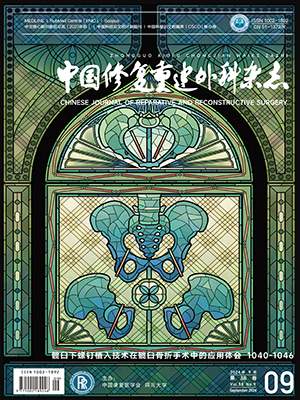Objective To find a feasible method that can reconstruct the composite tissue-engineered skin fast in vitro and can provide enoughskin as soon as possible for covering the surface of the large-area burn. Methods The foreskin was taken during the posthectomy. The epidermal cells and fibroblasts were isolated, identified and cultured. The cytokeratin 19 (K19) flow cytometry and the fluorescein isothiocyanate (FITC)immunofluorescence for K19 and the FITCimmunofluorescence for PAN-cytokeratin of the epidermal cells and the FITCimmunofluorescence for vimentin of the fibroblasts were performed to identify the epidermal cells and the fibroblasts. Then, the epidermal cells were seeded onto the papillary surface of an acellular dermal matrix (ADM) and were submerged into the condition culture medium added with 25 ng/ml of the keratinocyte growth factor (KGF). However, in the control group, no KGFwas added. After 24 hours, the ADM was moved up to the airfluid surface, and the culture was continued. After 6 days, the fibroblasts were seeded onto the other surface of the ADM. After a 24 hour culture, the ADM was harvested and fixed in formalin, and the hematoxylin-eosin staining was conducted. Then, the structure of the reconstructed skin was observed under the microscope and the cell count in the epidermal layer was also conducted. Results All the cultured and expanded epidermal cells stained by the immunofluorescence demonstrated a positive reaction for PANFITC, and a partially positive for K19-FITC, and 17% of the cells demonstrated a positive reaction for K19 identified by the flow cytometry. The fibroblasts could be expanded by more than 100 times after a 7day culture in vitro, and they could demonstrate a positive reaction for vimentin-FITC. After a 7day culture, a composite tissue-engineered skin could be attained. The hematoxylineosin staining of the reconstructed skin showed that there was one continuous layer of the epidermis on the papillary surface of the ADM and there were fibroblasts in the superficial layer of the other one, but the epidermal layer did not stick tightly to the ADM. The cell count demonstrated that KGF promoted the epidermal cells to proliferate better(P lt;0.01)and to form more significantly continuous layers of the epidermis in the experimental group than in the control group(P lt;0.01). Conclusion Through the seed-cell separation by the digestion of collagenase and trypsin combined with the use of the KGF-added condition ulture medium, a composite tissueengineered skin can be reconstructed within 7 days.
Citation: YANG Bin,HONG Qingqi,QIU Risheng,et al.. FAST RECONSTRUCTION OF COMPOSITE TISSUE-ENGINEERED SKIN IN VITRO. Chinese Journal of Reparative and Reconstructive Surgery, 2007, 21(4): 406-410. doi: Copy




